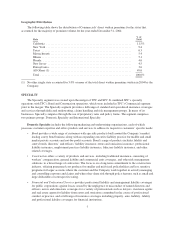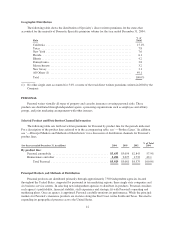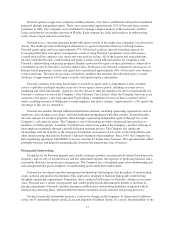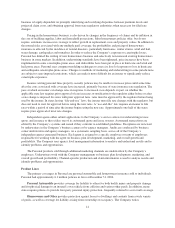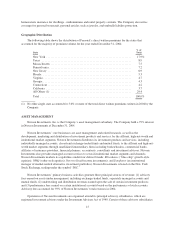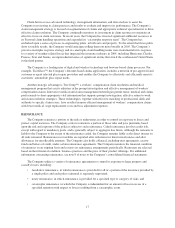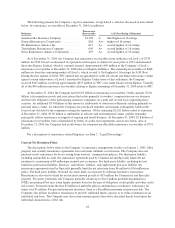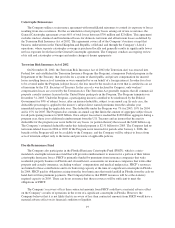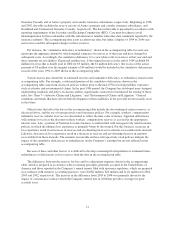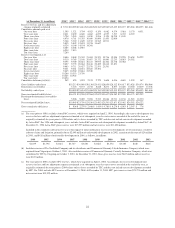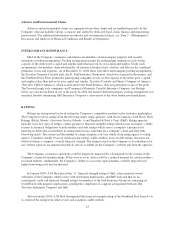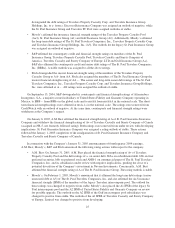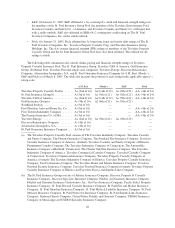Travelers 2004 Annual Report Download - page 29
Download and view the complete annual report
Please find page 29 of the 2004 Travelers annual report below. You can navigate through the pages in the report by either clicking on the pages listed below, or by using the keyword search tool below to find specific information within the annual report.Claim Services uses advanced technology, management information, and data analysis to assist the
Company in reviewing its claim practices and results to evaluate and improve its performance. The Company’s
claim management strategy is focused on segmentation of claims and appropriate technical specialization to drive
effective claim resolution. The Company continually monitors its investment in claim resources to maintain an
effective focus on claim outcomes. In recent years, the Company has invested significant additional resources in
its Personal claim handling operations and expanded its “catastrophe response team”. The Company has
embarked upon a series of process re-engineering pilots, in both auto and property. To the extent that those pilots
show favorable results, the Company would anticipate rolling them out more broadly in 2005. The Company’s
proven catastrophe response strategy and its catastrophe claim handling teams were instrumental in its response
to a variety of weather-related losses that impacted the insurance industry in 2004, including Hurricanes Charley,
Frances, Ivan and Jeanne, an unprecedented series of significant storms that struck the southeastern United States
in the third quarter.
The Company is a leading user of digital and wireless technology and browser-based claim processes. For
example, TravGlassSM, the Company’s Internet-based claims application, includes a network of pre-approved and
customer or agent selected glass repair providers and enables the Company to effectively and efficiently meet its
customers’ automobile glass repair needs.
Another strategic advantage is TravCompSM, a workers’ compensation claim resolution and medical
management program that assists adjusters in the prompt investigation and effective management of workers’
compensation claims. Innovative medical and claims management technologies permit nurse, medical and claims
professionals to share appropriate vital information that supports prompt investigation, effective return to work
and claim resolution strategies. These technologies, together with effective matching of professional skills and
authority to specific claim issues, have resulted in more efficient management of workers’ compensation claims
with lower medical, wage replacement costs and loss adjustment expenses.
REINSURANCE
The Company reinsures a portion of the risks it underwrites in order to control its exposure to losses and
protect capital resources. The Company cedes to reinsurers a portion of these risks and pays premiums based
upon the risk and exposure of the policies subject to such reinsurance. Ceded reinsurance involves credit risk,
except with regard to mandatory pools, and is generally subject to aggregate loss limits. Although the reinsurer is
liable to the Company to the extent of the reinsurance ceded, the Company remains liable as the direct insurer on
all risks reinsured. Reinsurance recoverables are reported after reductions for known insolvencies and after
allowances for uncollectible amounts. The Company also holds collateral, including trust agreements, escrow
funds and letters of credit, under certain reinsurance agreements. The Company monitors the financial condition
of reinsurers on an ongoing basis and reviews its reinsurance arrangements periodically. Reinsurers are selected
based on their financial condition, business practices and the price of their product offerings. For additional
information concerning reinsurance, see note 8 of notes to the Company’s consolidated financial statements.
The Company utilizes a variety of reinsurance agreements to control its exposure to large property and
casualty losses, including:
• facultative reinsurance, in which reinsurance is provided for all or a portion of the insurance provided by
a single policy and each policy reinsured is separately negotiated;
• treaty reinsurance, in which reinsurance is provided for a specified type or category of risks; and
• catastrophe reinsurance, in which the Company is indemnified for an amount of loss in excess of a
specified retention with respect to losses resulting from a catastrophic event.
17


